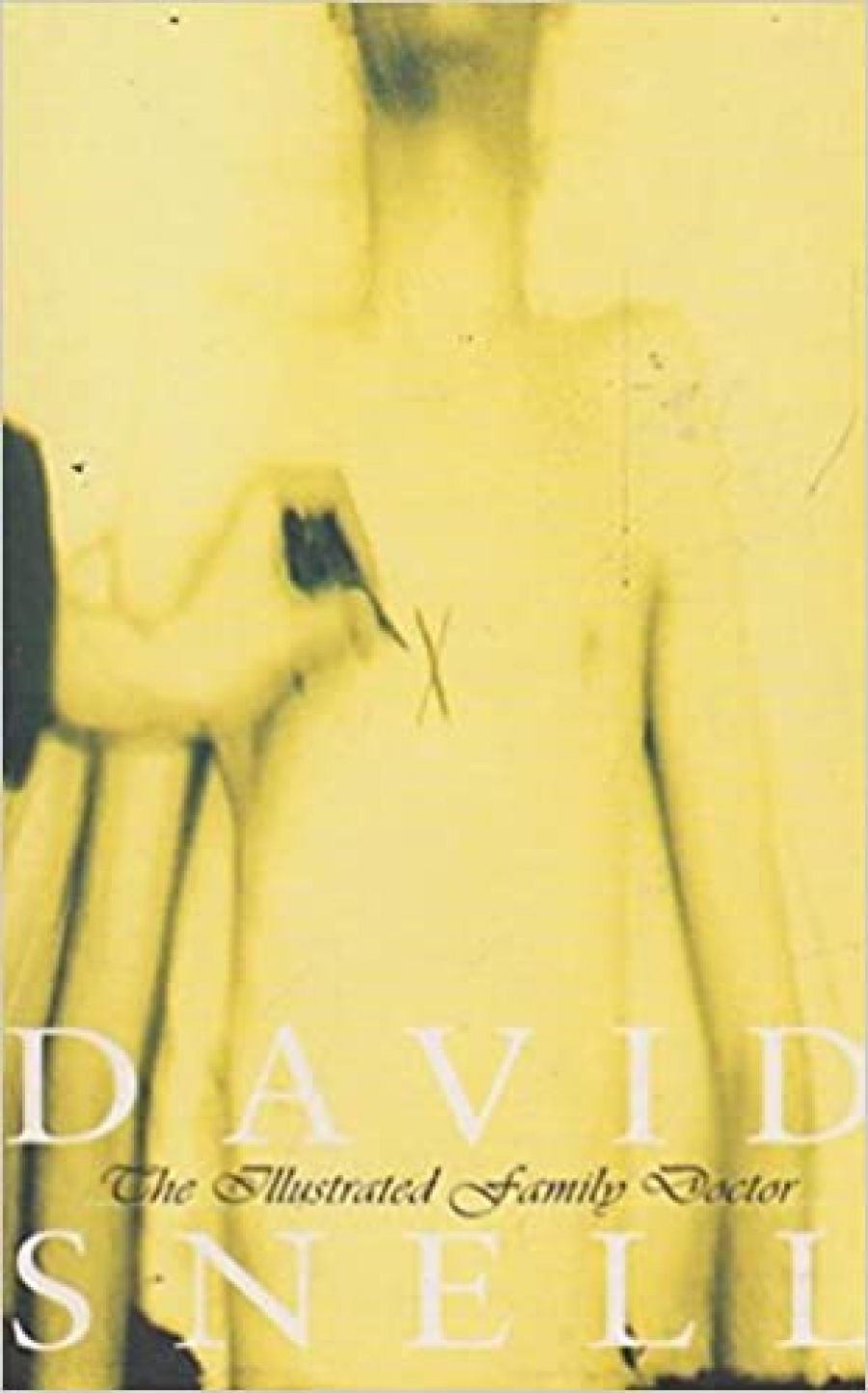
- Free Article: No
- Contents Category: Fiction
- Review Article: Yes
- Online Only: No
- Custom Highlight Text:
How do you define despair? You might choose to describe it as ‘a chemical imbalance of the brain, resulting in fragmented perceptions, often associated with grief and pessimism’. That is the definition Gary Kelp comes across in the course of his working day. It seems to fit. ‘I imagined a picture of myself to go with the text,’ he says, ‘sitting there at the bar, staring into my drink.’
- Book 1 Title: The Illustrated Family Doctor
- Book 1 Biblio: Picador, $16.95 pb, 283 pp
The diagrams, the colour photos in lurid reds of cancerous skin colonies, scalps eaten away by fungal bacteria in ghastly purples, the most banal expressions on the faces of the models. A thyroid erupting like a balloon on a woman’s neck while she looks into the camera like she’s been hijacked by a psychotic serial killer: her own body.
David Snell’s novel is haunted by the body and its unreliability, its constant changes of state. Dying, decaying, leaking, secreting, ejaculating, developing growths and tumours. The body amputated, transplanted, recycled, used for experiments. The whole and its parts. In particular, Gary Kelp is haunted by the memory of his father lying in the morgue, and the shock of the discovery that the body had been ‘harvested’ for medical experiments – that it was disconcertingly, almost comically, incomplete. And gradually, in the course of the novel, his own body begins to fail him, in ways both comic and tragic.
In The Illustrated Family Doctor, the body is also metaphor, image and emblem. It stands for anything and everything. As he travels to work on the bus, Gary ponders individuality and difference. ‘It occurred to me that the man in blue and I were the same. We were the red blood cells in the body of this city. We moved along this artery every day, like pre-programmed cells performing a function.’ The personnel department at Information Digest tries to hijack metaphor, to portray itself as human and humane by presenting itself as ‘a shoulder to cry on. We’re all ears here at Human Resources’. Seeing the body everywhere can have its nightmarish side: Gary contemplates ‘fleshy sculptures made of brown metal [which] look like warty vaginas with fangs’. The novel is full of characters with notable physical traits or particular obsessions about the body.
Snell emphasises this, punctuating his novel with fragments of writing which might have come from the text Gary is supposed to update: sentences, headings and odd little titbits of information strategically placed in the narrative. ‘A man’s testicles manufacture 10 million new sperm cells a day. Enough in eighteen months to populate the entire world.’ ‘How to remove a foreign body from the upper eyelid.’ ‘An intense fear of developing cancer has become so widespread doctors are treating it as a phobia and refer to it generally as cancerphobia.’
The Illustrated Family Doctor is not, however, simply a catalogue of the body in crisis: it is also a comedy about work, about the death and decay of a workplace, its gradual dismemberment in the name of efficiency.
At first, Snell gives us a picture of work as daily routine, deftly presenting the exchange of familiar greetings, the drearily comforting rituals of places, names, activities, conversational sallies repeated over and over and over again. Changes are taking place at the same time. Information Digest is being transformed: human bodies are being removed from the offices and replaced by hardware and software, by machines, programs, databases, scanners. There’s a bleak comic touch in this aspect of the book, a kind of offhand knowing humour about the inevitability of economic rationalism, and its fundamental unstoppable absurdity. The staff celebrations for the 200th anniversary of the Digest are excruciatingly hypocritical. Snell has a bleak comic touch, a deft combination of the satirical and the sinister, as it becomes apparent there is something rotten in the state of things at Information Digest.
The definition of despair which Gary stumbled upon comes close to describing the way The Illustrated Family Doctor evokes, in episodic, fragmentary fashion, the operation of grief. In its own way, the novel is also a source of condensed stories, although not of the kind that Information Digest produces. It is made up of episodic moments; characters who make fleeting but memorable appearances; emblematic, telling incidents; dreams that are not always easy to differentiate from waking states. It concludes with intriguing restating of the act of storytelling, a curious, ambiguous affirmation. The Illustrated Family Doctor is marked by dark humour, an interest in the sticky, messy awkwardness of things and a kind of melancholy relish.


Comments powered by CComment